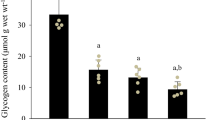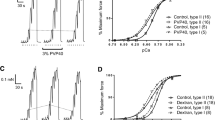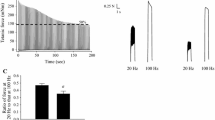Abstract
The ability of mechanically skinned muscle fibres from the rat to respond to T-system depolarisation was studied in relation to muscle glycogen content. Muscle glycogen was altered by incubating extensor digitorum longus (EDL) muscles in Krebs solution without glucose or in Krebs solution with glucose (10 mM) and insulin (20 U·l–1). The glycogen content of muscles stored without glucose was rather stable between 30 and 480 min (11.27±0.39 µmol·g–1), while the muscles stored with glucose and insulin maintained an elevated and stable level of glycogen (23.48±1.67 µmol·g–1) between 100 and 360 min. Single mechanically skinned fibres from paired muscles, incubated in either glucose-free Krebs or in Krebs with glucose and insulin, were subjected to cycles of T-system depolarisation–repolarisation in a controlled environment (8 mM ATP, 10 mM creatine phosphate, 1 mM Mg2+, pH 7.10) and the force response was monitored until the force had declined to 50% of the maximum response (50% rundown). Fibres from muscles with a higher glycogen content reached 50% rundown after a larger number of depolarisations and displayed consistently larger average response capacity values, calculated as the sum of the force responses to 50% rundown divided by the maximum Ca2+-activated force response in that fibre. Thus skinned fibres originating from muscles with a higher glycogen content have an increased ability to respond to T-system depolarisation when the effect of metabolite accumulation is minimised and the function of glycogen acting as an energy source is by-passed. This provides direct support to the hypothesis that glycogen has a protective role in maintaining fibre excitability.
Similar content being viewed by others
Author information
Authors and Affiliations
Additional information
Received after revison: 15 October 2000
Electronic Publication
Rights and permissions
About this article
Cite this article
Barnes, M., Gibson, L. & Stephenson, D. Increased muscle glycogen content is associated with increased capacity to respond to T-system depolarisation in mechanically skinned skeletal muscle fibres from the rat. Pflügers Arch - Eur J Physiol 442, 101–106 (2001). https://doi.org/10.1007/s004240000510
Received:
Accepted:
Published:
Issue Date:
DOI: https://doi.org/10.1007/s004240000510




